ClimateCafé: An Interdisciplinary Educational Tool for Sustainable Climate Adaptation and Lessons Learned
Abstract
:1. Introduction
Study Area
2. Materials and Methods
2.1. Storytelling and the Impact of Malmö ClimateCafé
2.2. Mapping of Climate Adaptation Measures with the ClimateScan Tool
2.3. Quick Scan Mapping of Pollutants with the Use of Portable XRF
2.4. Water Quality
2.5. Hydraulic Efficiency of Swales
2.6. Heat Stress Mapping with Sensors on a Bike
3. Results
3.1. Storytelling and the Impact of Malmö ClimateCafé
3.2. Mapping of Climate Adaptation Measures with the ClimateScan Tool
3.3. Quick scan Mapping of Pollutants with the Use of Portable XRF
3.4. Water Quality
3.5. Hydraulic Efficiency of Swales
3.6. Heat Stress Mapping
4. Discussion
4.1. The Interdiciplinary Approach for Climate Adaptation
4.2. The Impact of the Different Diciplines on the Participants
5. Conclusions
Author Contributions
Funding
Acknowledgments
Conflicts of Interest
References
- Global Commission on Adaptation Adapt Now: A Global Call for Leadership on Climate Resilience; Global Center on Adaptation: Groningen/Rotterdam, The Netherlands, 2019; Available online: https://cdn.gca.org/assets/2019-09/GlobalCommission_Report_FINAL.pdf (accessed on 27 April 2020).
- Intergovernmental Panel on Climate Change. IPCC Special Report on Climate Change, Desertification, Land Degradation, Sustainable Land Management, Food Security, and Greenhouse Gas Fluxes in Terrestrial Ecosystems. Summary for Policymakers. Geneva: IPCC. 2019. Available online: https://www.ipcc.ch/report/srccl/ (accessed on 15 August 2019).
- Sovacool, B.K. Energy studies need social science. Nature 2014, 511, 186–197. [Google Scholar] [CrossRef]
- Sovacool, B.K.; Ryan, S.E.; Stern, P.C.; Janda, K.; Rochlin, G.; Spreng, G.; Pasqualetti, M.J.; Wilhite, H.; Lutzenhiser, L. Integrating social science in energy research. Energy Res. Soc. Sci. 2015, 6, 95–99. [Google Scholar] [CrossRef]
- Wallenborn, G.; Wilhite, H. Rethinking embodied knowledge and household consumption. Energy Res. Soc. Sci. 2014, 1, 56–64. [Google Scholar] [CrossRef]
- Lutzenhiser, L. Through the energy looking glass. Res. Soc. Sci. 2014, 1, 141–151. [Google Scholar]
- Urmetzer, S.; Lask, J.; Vargas-Carpintero, R.; Pyka, A. Learning to change: Transformative knowledge for building a sustainable bioeconomy. Ecol. Econ. 2020, 167, 106435. [Google Scholar] [CrossRef]
- Nesshöver, C.; Assmuth, T.; Irvine, K.N.; Rusch, G.M.; Waylen, K.A.; Delbaere, B.; Haase, D.; Jones-Walters, J.; Keune, H.; Kovacs, E.; et al. The science, policy and practice of nature-based solutions: An interdisciplinary perspective. Sci. Total Environ. 2017, 579, 1215–1227. [Google Scholar] [CrossRef]
- Albert, C.; Spangenberg, J.; Schröter, B. Nature-based solutions: Criteria. Nature 2017, 543, 315. [Google Scholar] [CrossRef]
- Majidi, A.N.; Vojinovic, Z.; Alves, A.; Weesakul, S.; Sanchez, A.; Boogaard, F.; Kluck, J. Planning Nature-Based Solutions for Urban Flood Reduction and Thermal Comfort Enhancement. Sustainability 2019, 11, 6361. [Google Scholar] [CrossRef] [Green Version]
- Bauduceau, N.; Berry, P.; Cecchi, C.; Elmqvist, T.; Fernandez, M.; Hartig, T.; Krull, W.; Mayerhofer, E.; Luise-Noring, S.N.; Raskin-Delisle, K.; et al. Towards an EU Research and Innovation Policy Agenda for Nature-Based Solutions & Re-Naturing Cities, Final Report of the Horizon 2020 Expert Group on ‘Nature-Based Solutions and Re-Naturing Cities’; Publications Office of the European Union: Bruxelles, Belgium, 2015. [Google Scholar]
- Raymond, C.M.; Frantzeskaki, N.; Kabisch, N.; Berry, P.; Breil, M.; Nita, M.R.; Geneletti, D.; Calfapietra, C. A framework for assessing and implementing the co-benefits of nature-based solutions in urban areas. Environ. Sci. Policy 2017, 77, 15–24. [Google Scholar] [CrossRef]
- Kastens, K.A.; Manduca, C.A.; Cervato, C.; Frodeman, R.; Goodwin, C.; Liben, L.S.; Mogk, D.W.; Spangler, T.C.; Stillings, N.A.; Titus, S. How geoscientists think and learn. EOS 2009, 31, 265–266. [Google Scholar] [CrossRef]
- Dewey, J. Experience and Education; Macmillian: New York, NY, USA, 1969. [Google Scholar]
- Carayannis, E.G.; Campbell, D.F.J. Mode 3′ and ‘Quadruple Helix’: Toward a 21st century fractal innovation ecosystem. Int. J. Technol. Manag. 2009, 46, 201–234. [Google Scholar] [CrossRef] [Green Version]
- Colloff, M.M.; Martín-López, B.; Lavorel, S.; Locatelli, B.; Gorddard, R.; Longaretti, P.Y.; Walters, G.; van Kerkhoff, L.; Wyborn, C.; Coreau, A.; et al. An Integrative Research Framework for Enabling Transformative Adaptation. Environ. Sci. Policy 2017, 68, 87–96. [Google Scholar] [CrossRef]
- Tompkins, E.L.; Eakin, H. Managing private and public adaptation to climate change. Glob. Environ. Chang. 2012, 22, 3–11. [Google Scholar] [CrossRef] [Green Version]
- Wamsler, C.; Raggers, S. Principles for supporting city-citizen communing for climate adaptation: From Adaptation Governance to sustainable transformation. Environ. Sci. Policy 2018, 85, 81–89. [Google Scholar] [CrossRef]
- Leal, F.W. Communicating climate change: Challenges ahead and action needed. Int. J. Clim. Chang. Strateg Manag. 2009, 1, 6–18. [Google Scholar] [CrossRef]
- Leal, F.W.; Manolas, E.; Azul, A.M.; Azeiteiro, U.M.; McGhie, H. (Eds.) Handbook of Climate Change Communication: Theory of Climate Change Communication; Springer: Berlin, Germany, 2018; Volume 1. [Google Scholar]
- Hoffmann, R.; Muttarak, R. Learn from the Past, Prepare for the Future: Impacts of Education and Experience on Disaster Preparedness in the Philippines and Thailand. World Dev. 2017, 96, 32–51. [Google Scholar] [CrossRef] [Green Version]
- UN Sustainable Development Goals, Sustainable Development Goal Page. Available online: https://sustainabledevelopment.un.org/sdgs (accessed on 6 December 2019).
- UNESCO. Education for People and Planet: Creating Sustainable Futures for All (Global Education Monitoring Report 2016); United Nations: Paris, France, 2016. [Google Scholar]
- UNISDR. Disaster Risk Reduction and Resilience in the 2030 Agenda for Sustainable Development; The United Nations Office for Disaster Risk Reduction (UNISDR): Geneva, Switzerland, 2015; Available online: http://www.unisdr.org/files/46052_disasterriskreductioninthe2030agend.pdf (accessed on 27 April 2020).
- Stahre, P. Blue-Green Fingerprints in the City of Malmö, Sweden: Malmö’s way Towards a Sustainable Urban Drainage, Malmö, VA Syd. 2008. Available online: https://www.vasyd.se/~/media/Documents/Broschyrer/Vatten%20och%20avlopp/Dagvatten/BlueGreenFingerprintsPeterStahrewebb.ashx (accessed on 5 December 2019).
- Niemczynowicz, J. Urban hydrology and water management—Present and future challenges. Urban Water 1999, 1, 1–14. [Google Scholar] [CrossRef]
- The Scandinavian Green Infrastructure Association, Augustenborg—The Eco City. Available online: https://greenroof.se/en/eco-city (accessed on 6 December 2019).
- Climate Adapt—Optimization of the Mix of Private and Public Funding to Realise Climate Adaptation Measures in Malmö. 2016. Available online: https://climate-adapt.eea.europa.eu/metadata/case-studies/optimization-of-the-mix-of-private-and-public-funding-to-realise-climate-adaptation-measures-in-malmo (accessed on 6 December 2019).
- Moezzi, M.; Janda, K.B.; Rotmann, S. Using stories, narratives, and storytelling in energy and climate change research. Energy Res. Soc. Sci. 2017, 31, 1–10. [Google Scholar]
- Harper, S.L.; Edge, V.L.; Cunsolo Willox, A. Changing climate, changing health, changing stories’ profile: Using an EcoHealth approach to explore impacts of climate change on inuit health. Ecohealth 2012, 9, 89–101. [Google Scholar] [CrossRef]
- ClimateScan. Available online: www.climatescan.org (accessed on 10 November 2019).
- Boogaard, F.; Liinamaa-Dehls, A.; Restemeyer, B.; Venvik, G. Knowledge Exchange on Climate Adaptation with Nature-Based Solutions and Best Management Practices for Sustainable (Ground)Water Management in Resilient Cities; IAH Groundwater management and governance: Malaga, Spain, 2019. [Google Scholar]
- Boogaard, F.; Lucke, T. Long-term Infiltration Performance Evaluation of Dutch Permeable Pavements using the Full-Scale Infiltration Method. Water 2019, 11, 320. [Google Scholar] [CrossRef] [Green Version]
- Woods Ballard, B.; Wilson, S.; Udale-Clarke, H.; Illman, S.; Scott, T.; Ashely, R.; Kellagher, R. CIRIA—The SuDs Manual; CIRIA Research Project (RP)992; Department for Environment Food & Rural Affairs: London, UK, 2015; Available online: https://www.ciria.org/Memberships/The_SuDs_Manual_C753_Chapters.aspx (accessed on 28 April 2020).
- Fletcher, T.D.; Andrieu, H.; Hamel, P. Understanding, management and modelling of urban hydrology and its consequences for receiving waters; a state of the art. Adv. Water Resour. 2013, 51, 261–279. [Google Scholar] [CrossRef]
- Boogaard, F.C.; van de Ven, F.; Langeveld, J.; van de Giesen, N. Stormwater Quality Characteristics in (Dutch) Urban Areas and Performance of Settlement Basins. Challenges 2014, 5, 112–122. [Google Scholar] [CrossRef] [Green Version]
- Jones, P.S.; Davis, A.P. Spatial accumulation and strength of affiliation of heavy metals in bioretention media. J. Environ. Eng. 2013, 139, 479–487. [Google Scholar] [CrossRef]
- Thermofisher—XL3TGoldPlus XRF Analyzer. Available online: https://www.thermofisher.com/order/catalog/product/XL3TGOLDDPLUS?SID=srch-hj-XL3TGOLDDPLUS&fbclid=IwAR1Iv77E9Ebnt-qPvqeTRFHWf1nvVB5gk5TKAYLNtotqPAphtg8vQvEIOQs#/XL3TGOLDDPLUS?SID=srch-hj-XL3TGOLDDPLUS (accessed on 6 December 2019).
- Venvik, G.; Boogaard, F.C. Portable XRF Quick-Scan Mapping for Potential Toxic Elements Pollutants in Sustainable urban Drainage Systems: A Methodological. Approach. Sci. 2020, 2, 21. [Google Scholar] [CrossRef] [Green Version]
- Naeem, A. Runoff Water Quality from a Green Roof and in an Open Storm Water System TVVR, 2010, 10(5020) VVR820 20102. Available online: https://lup.lub.lu.se/student-papers/search/publication/2025468 (accessed on 6 December 2019).
- In-Situ Water Monitoring Equipment—TROLL 9500. Available online: https://in-situ.com/product-category/accessories/maintenance/9500-maintenance (accessed on 10 November 2019).
- Dissolved Oxygen Logger (PME MiniDOT). Available online: https://www.pme.com/new-products/minidot-usb-oxygen-logger (accessed on 10 November 2019).
- CTD (Van Essen Instruments CTD Diver). Available online: https://www.vanessen.com/products/water-level/ctd-diver (accessed on 10 November 2019).
- Algae/Chlorophyll Sensor (Trillux—Chelsea Technologies). Available online: https://chelsea.co.uk/products/trilux (accessed on 10 November 2019).
- de Lima, R.L.P.; Boogaard, F.C.; de Graaf-van Dinther, R.E. Innovative Water Quality and Ecology Monitoring Using Underwater Unmanned Vehicles: Field Applications, Challenges and Feedback from Water Managers. Water 2020, 12, 1196. [Google Scholar] [CrossRef] [Green Version]
- Boogaard, F.C. Stormwater Characteristics and New Testing Methods for Certain Sustainable Urban Drainage Systems in The Netherlands. Ph.D. Thesis, Technical University Delft, Delft, The Netherlands, 2015. [Google Scholar]
- Le Coustumer, S.; Fletcher, T.D.; Deletic, A.; Barraud, S.; Lewis, J.F. Hydraulic performance of biofilter systems for stormwater management: Influences of design and operation. J. Hydrol. 2009, 376, 16–23. [Google Scholar] [CrossRef]
- Le Coustumer, S.; Fletcher, T.D.; Deletic, A.; Barraud, S.; Poelsma, P. The influence of design parameters on clogging of stormwater biofilters: A large-scale column study. Water Res. 2012, 46, 6743–6752. [Google Scholar] [CrossRef]
- Ingvertsen, S.T.; Cederkvist, K.; Régent, Y.; Sommer, H.; Magid, J.; Jensen, M.B. Assessment of Existing Roadside Swales with Engineered Filter Soil: Characterization and Lifetime Expectancy. J. Environ. Qual. 2011, 41, 1960–1969. [Google Scholar] [CrossRef]
- United States Environmental Protection Agency, Heat Island Effect. Available online: https://www.epa.gov/heat-islands (accessed on 7 December 2019).
- Maimaitiyiming, M.; Ghulam, A.; Tiyip, T.; Pla, F.; Latorre-Carmona, P.; Halik, Ü.; Sawut, M.; Caetano, M. Effects of green space spatial pattern on land surface temperature: Implications for sustainable urban planning and climate change adaptation. ISPRS J. Photogramm. Remote Sens. 2014, 89, 59–66. [Google Scholar] [CrossRef] [Green Version]
- Arellano, B.; Roca, J. Can urban design mitigate the UHI effect? In Proceedings of the SPIE Remote Sensing, Berlin, Germany, 10–13 September 2018.
- Sun, R.; Chen, L. How can urban water bodies be designed for climate adaptation? Landsc. Urban Plan. 2012, 105, 27–33. [Google Scholar] [CrossRef]
- Höppe, P. The physiological equivalent temperature—A universal index for the biometeorological assessment of the thermal environment. Int. J. Biometeorol. 1999, 43, 71–75. [Google Scholar] [CrossRef] [PubMed]
- Naturvårdsverket. 1997. Available online: http://www.naturvardsverket.se/Stod-i-miljoarbetet/Rattsinformation/Foreskrifter-allmanna-rad/Foreskrifter-per-ar/1997/ (accessed on 10 November 2019).
- Kluge, B.; Markert, A.; Facklam, M.; Sommer, H.; Kaiser, M.; Pallasch, M.; Wessolek, G. Metal accumulation and hydraulic performance of bioretention systems after long-term operation. J. Soils Sediments 2016, 18, 431–441. [Google Scholar] [CrossRef]
- Lemmen, G.; Boogaard, F.; Schipper, P.; Wentink, R. 2008 Maintenance of SUDS. In Proceedings of the 11th ICUD, Edinburgh, Scotland, UK, 31 August–5 September 2008; Available online: https://www.climatescan.nl/uploads/projects/2850/files/370/ICUD%20paper%20Lemmen%20Maintenance%20SUDS%20762.00.pdf (accessed on 28 April 2020).








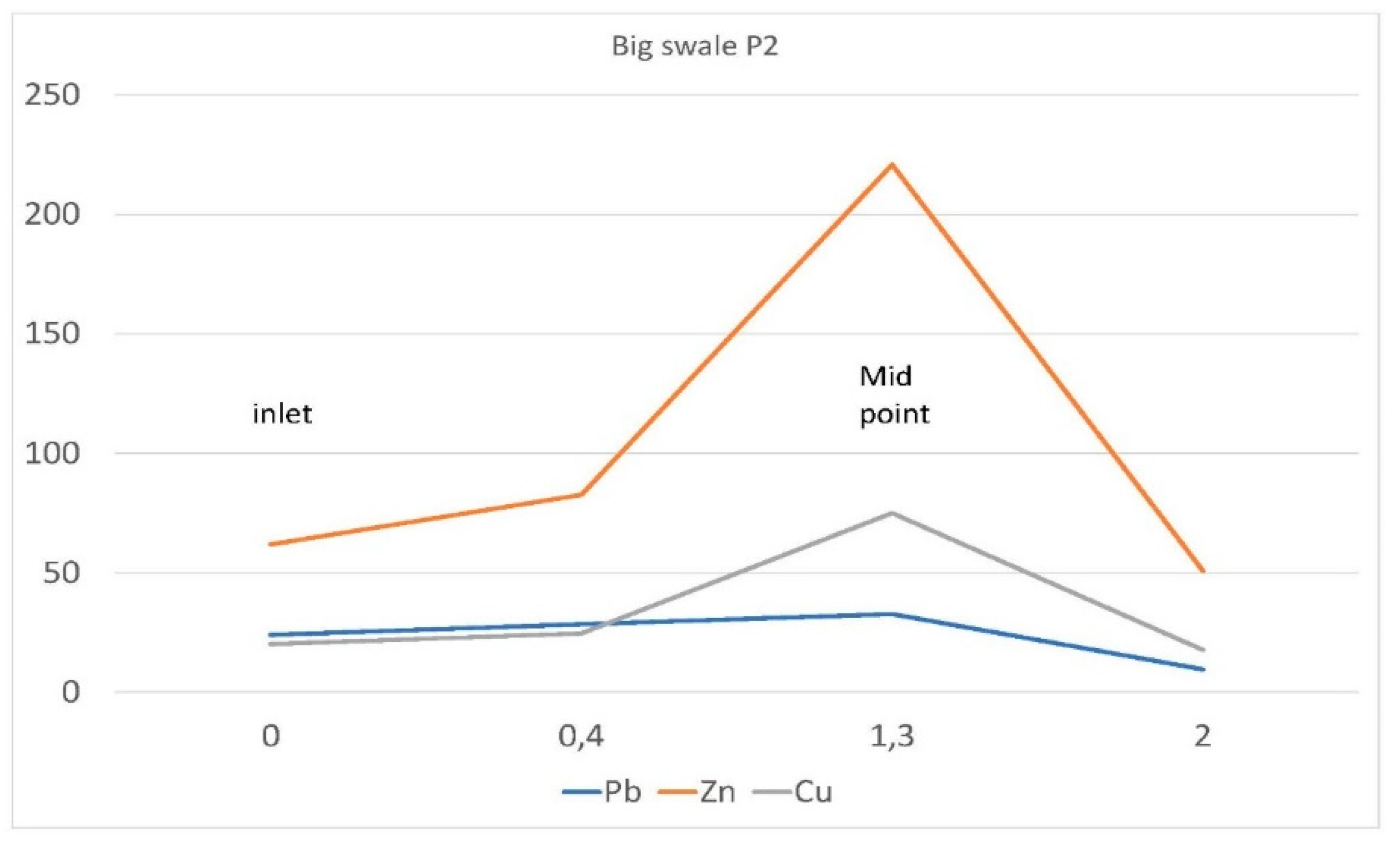
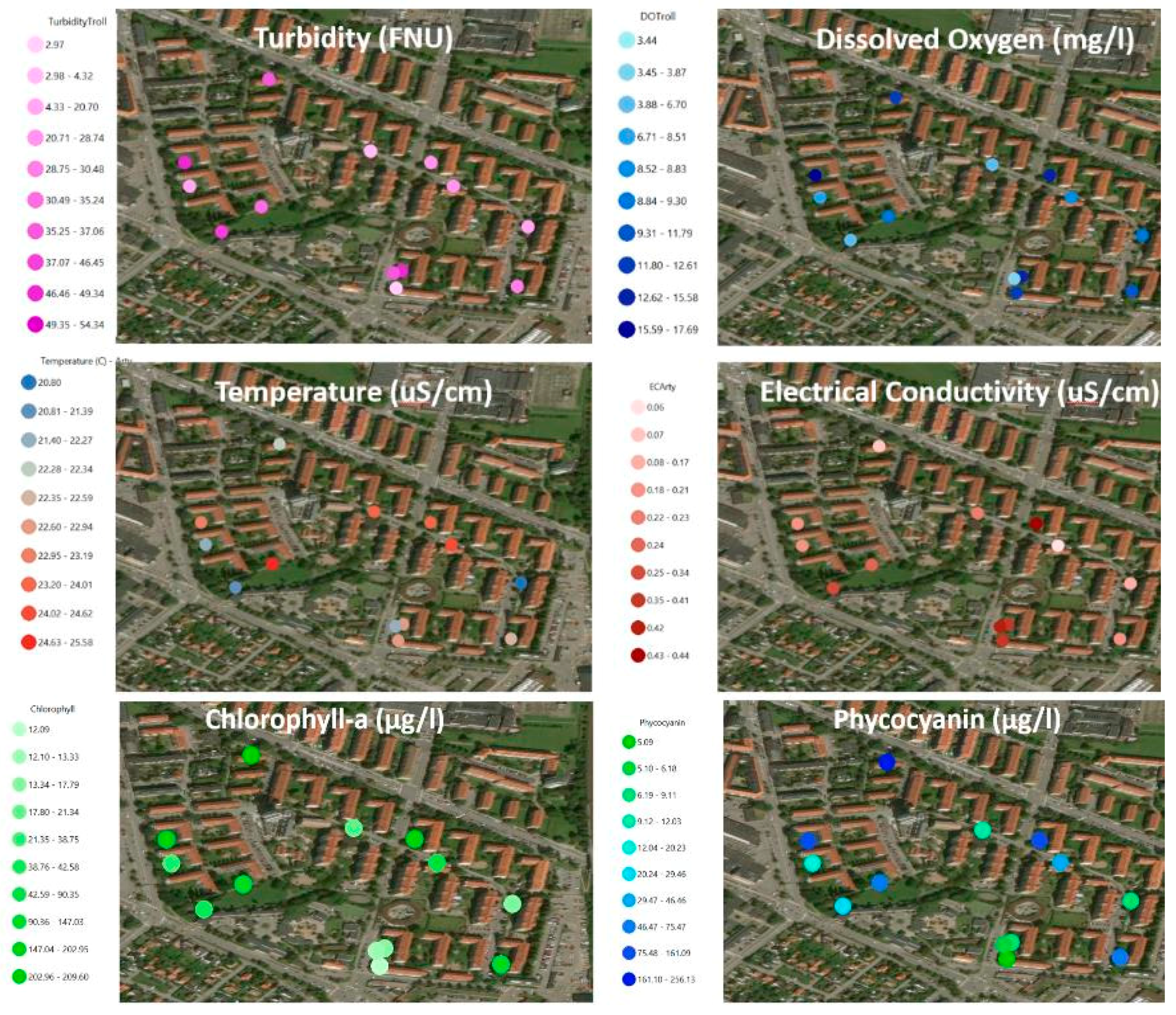





| Workshops | Workshop aim | Method | ||
|---|---|---|---|---|
| 1 | Storytelling | To enhance discussions regarding climate adaptation UN SDG #17: partnership for the goals, #4: quality education, #11: sustainable cities and communities | Interviews with participants of ClimateCafé and additional with different stakeholders (government, industry, academia, and civil participants) brought multidisciplinary viewpoints together and created new shared values that benefit Augustenborg to optimize the ecosystem services. | 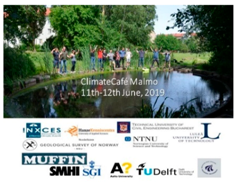 |
| 2 | Mapping climate adaptation on ClimateScan | To give first impressions of urban resilience projects and examples of existing sustainable climate adaptation. UN SDG #13: climate action, #11 and #9: innovation and infrastructure. | Climate adaptations were mapped on the open-source tool www.climatescan.org |  |
| 3 | Soil quality of NBS | To assess the built-up of potential toxic elements in the NBS in the study area UN SDG #6: clean water and sanitation, and #15: life on land. | A portable X-ray fluorescence (pXRF) instrument was used to measure the build-up of potential toxic elements (PTE) in the topsoil of rain gardens and swales after 20 years. A new method for cost-effective insights into the environmental performance of NBS. | 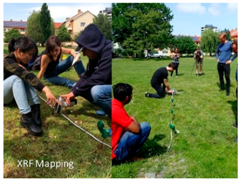 |
| 4 | Water quality assessment of NBS | To scan water quality in this neighborhood, and gain insights into the spatial variability of water quality between different ponds. UN SDG #14: life below water and #6. | The (surface) water quality of all ponds in Augustenborg was measured by underwater drones with cameras and sensors. | 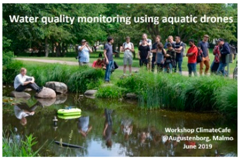 |
| 5 | Hydraulic performance of NBS | To gain more insight into the hydrological performance of NBS in the study area. UN SDG #6 and #13 | Full-scale testing of swales was conducted using sensors, resulting in detailed measurements of the infiltration capacity of these nature-based solutions | 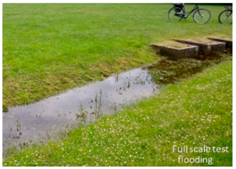 |
| 6 | Heat stress mapping | To gain more insight into heat stress and the effects of NBS on urban cooling inside and outside of the Augustenborg area. UN SDG #11 and #7: renewable energy | Heat sensors on bikes gave detailed information on ‘hotspots’ in Malmö where nature-based solutions could be implemented to mitigate high temperatures | 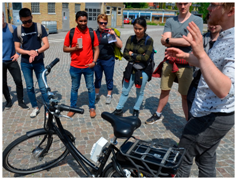 |
| Countries | Background | Field | What Are Your Thoughts about Climate Adaptation? | How did ClimateCafé Improve Skills about Climate Adaptation? |
|---|---|---|---|---|
| Sweden (7) Sri Lanka (1) Indonesia (1) Czech Republic (1) Romania (2) Latvia (6) China (1) Belgium (1) | PhD students (5) Masters students (7) Bachelors students (1) Professionals (7) | Stormwater quality Civil engineering Water resources engineering Environmental engineering Landscape architecture Groundwater engineering Urban drainage system Water management | Need to educate people | More knowledge about climate adaptation (discussions) |
| Need more studies, more knowledge | More knowledge about climate adaptation (new techniques) | |||
| Important due to climate change (e.g., disasters) | Networking (people from different backgrounds/countries) | |||
| It’s a challenge | ||||
| Ongoing field with a lot already happening | Spread the knowledge known to hometowns | |||
| Important topic to spread to other stakeholders, e.g., municipalities | Experience theory on field (by measurements) | |||
| Do not have a strict opinion, need more time to verify if climate is changing | Inspiration for future studies by solutions already applied on field | |||
| Necessity of more resilient cities |
| Sensor | Variables Collected | Output | Precision |
|---|---|---|---|
| BME280 | Air temperature, humidity | Temperature in Degrees Celsius, Humidity in 5 | ± 3% |
| MLX90615 | Infrared temperature, air temperature | Temperature in Degrees Celsius | ± 3% |
| BH1750FVI | Light intensity | Lux | ± 2% |
| Velleman Anemometer WS1080 | Windspeed | Wind speed in km/h | ±0.5 km/h |
| GY-NEO6MV2 | GPS | Lat/long | Depending on satellite connections |
| Participants Have Learned How to Use the Proposed Tools during Malmö ClimateCafé | ||||||
|---|---|---|---|---|---|---|
| Strongly disagree | Neutral to strongly disagree | Neutral | Strongly agree to neutral | Strongly agree | Sum | |
| SDGs | 20% | 10% | 20% | 30% | 20% | 100% |
| FullScale | 0% | 10% | 20% | 40% | 30% | 100% |
| Water drones | 0% | 0% | 20% | 40% | 40% | 100% |
| pXRF | 0% | 0% | 10% | 20% | 70% | 100% |
| ClimateScan | 0% | 0% | 0% | 10% | 90% | 100% |
| Participants can explain the proposed tools during Malmö ClimateCafé to colleagues / fellow students after attending it | ||||||
| Strongly disagree | Neutral to strongly disagree | Neutral | Strongly agree to neutral | Strongly agree | Sum | |
| SDGs | 0% | 0% | 50% | 30% | 20% | 100% |
| FullScale | 0% | 10% | 20% | 50% | 20% | 100% |
| Water drones | 0% | 0% | 20% | 40% | 40% | 100% |
| pXRF | 0% | 0% | 10% | 30% | 60% | 100% |
| ClimateScan | 0% | 0% | 0% | 20% | 80% | 100% |
| The proposed tools are of value to the participants’ work/study and he/she is inclined to use it in the future. | ||||||
| Strongly disagree | Neutral to strongly disagree | Neutral | Strongly agree to neutral | Strongly agree | Sum | |
| SDGs | 0% | 0% | 10% | 30% | 60% | 100% |
| FullScale | 0% | 0% | 20% | 50% | 30% | 100% |
| Water drones | 0% | 0% | 20% | 40% | 40% | 100% |
| pXRF | 0% | 0% | 0% | 20% | 80% | 100% |
| ClimateScan | 0% | 0% | 20% | 30% | 50% | 100% |
| Logger | Slope | R2 | k (cm/min) | k (m/d) | |
|---|---|---|---|---|---|
| Swale 1 | Logger 1 | −21.804 | 0.9594 | 0.0174 | 0.23 |
| Swale 1 | Logger 2 | −24.571 | 0.9702 | 0.0155 | 0.20 |
| Swale 2 | Logger 1 | −15.824 | 0.9865 | 0.0112 | 0.15 |
© 2020 by the authors. Licensee MDPI, Basel, Switzerland. This article is an open access article distributed under the terms and conditions of the Creative Commons Attribution (CC BY) license (http://creativecommons.org/licenses/by/4.0/).
Share and Cite
Boogaard, F.C.; Venvik, G.; Pedroso de Lima, R.L.; Cassanti, A.C.; Roest, A.H.; Zuurman, A. ClimateCafé: An Interdisciplinary Educational Tool for Sustainable Climate Adaptation and Lessons Learned. Sustainability 2020, 12, 3694. https://doi.org/10.3390/su12093694
Boogaard FC, Venvik G, Pedroso de Lima RL, Cassanti AC, Roest AH, Zuurman A. ClimateCafé: An Interdisciplinary Educational Tool for Sustainable Climate Adaptation and Lessons Learned. Sustainability. 2020; 12(9):3694. https://doi.org/10.3390/su12093694
Chicago/Turabian StyleBoogaard, Floris C., Guri Venvik, Rui L. Pedroso de Lima, Ana C. Cassanti, Allard H. Roest, and Antal Zuurman. 2020. "ClimateCafé: An Interdisciplinary Educational Tool for Sustainable Climate Adaptation and Lessons Learned" Sustainability 12, no. 9: 3694. https://doi.org/10.3390/su12093694






